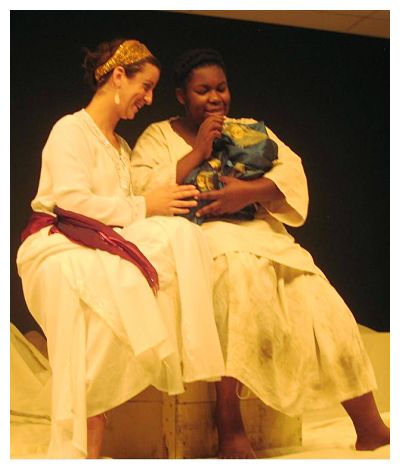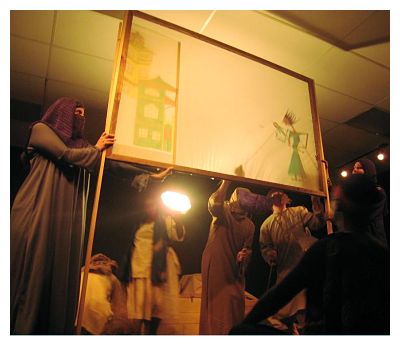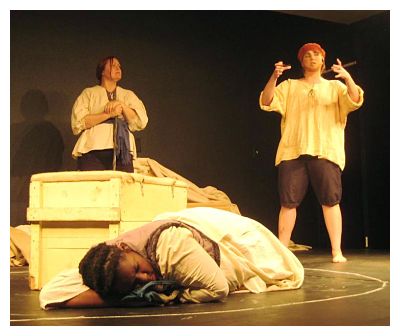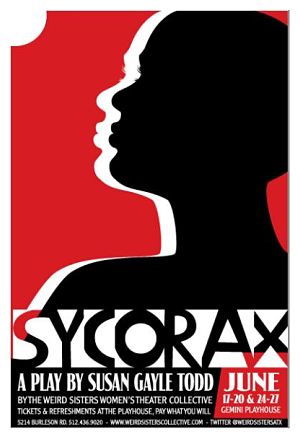Review: Sycorax by Weird Sisters Women's Theater Collective
by Michael Meigs
The foul witch Sycorax, who with age and envy
Was grown into a hoop? Hast thou forgot her?
The Tempest opens with a brief scene of desperation, with sailors and passengers struggling against an overwhelming storm. Following that vivid moment, in Act I, Scene 2 Shakespeare gives us a full measure of background and exposition.
He paints a huge and vivid canvas. Prospero reviews for his daughter Miranda in great detail the plot that expelled them both from Naples, casts a sleeping spell upon Miranda, interrogates Ariel and recalls the black spell cast by "the foul witch Sycorax." Waking Miranda, the magician calls forth the "poisonous slave" Caliban, son of Sycorax. Master and monster engage in snarling dialogue that tells us how Prospero overcame the "hag-seed" Caliban, taking away his dominion of the island, humiliating him and enslaving him as reprisal for lusting after Miranda.
With all those antecedents in place, the action of The Tempest begins as Ariel with enchantment and song drives Ferndinand, son of the King of Naples, onto the stage.
Susan Gayle Todd, a founding member of the six-year-old Weird Sisters Theater Collective, rolled Shakespeare's canvas back, locating a wide, almost blank panel. It was barely touched with the outline of Sycorax, a hint of Ariel's service to the witch, and an unelaborated event in Algiers that resulted in banishment, since "for one thing she did/ They would not take her life." Todd tells the imagined story of Sycorax as a woman healer, an African woman in Arabic Algiers.
The David Mark Cohen New Play Festival at the University of Texas featured the first production of this script two years ago. The Sisters' staging of Todd's story is an audacious undertaking. Their aim is both artistic and didactic, in keeping with the collective's 2004 manifesto, which reads, in part "we celebrate women—female artists, and even fictitious female characters who shape our understanding of real-live women—who have been silenced or vilified as a result of pervading, institutionalized sexism." As rendered, this new panel of canvas is dark but touched with vivid incident and accompanied by Chris Humphrey's music, rhythmic and evocative both of north Africa and of the sub-Sahara.

 Todd, a Shakespeare scholar and teacher with a recent Ph.D. from the University of Texas, opens the play with a lengthy extract from the exposition in Act I, Scene 2, before moving back in time to Algiers. The narrative switches forward and back in time, with the voyage to banishment interrupted by scenes of Sycorax's apprenticeship, her healing career, a duplicitous success in treating the sterility of the governor of Algiers, witch-hunting by the populace seeking a scapegoat for the ravages of a tempest, a lively mocking puppet show, and her arrival on the island accompanied by Ariel.
Todd, a Shakespeare scholar and teacher with a recent Ph.D. from the University of Texas, opens the play with a lengthy extract from the exposition in Act I, Scene 2, before moving back in time to Algiers. The narrative switches forward and back in time, with the voyage to banishment interrupted by scenes of Sycorax's apprenticeship, her healing career, a duplicitous success in treating the sterility of the governor of Algiers, witch-hunting by the populace seeking a scapegoat for the ravages of a tempest, a lively mocking puppet show, and her arrival on the island accompanied by Ariel.
Central both visually and in terms of plot is the enigmatic relationship between the lithe, dancing, precise and sparkling Ariel (Feliz Dia McDonald) and the Sycorax generations. Azure D. Osborne-Lee plays both Sycorax the healer and her offspring Caliban. Osborne-Lee is strong of bone and body, depicting the title character as assertive and yet uncertain of her gifts.
Playwright Todd and director Christa French move these characters between the realm of the physical and that of the spiritual. We do not know whether Ariel is a mere fevered imagining for Sycorax or a familiar spirit with powers. The rabble of Algiers burn Clare as a witch but Clare continues as a living presence in the life and misfortunes of Sycorax.
In Todd's story the grateful governor of Algiers commissions a full-size onyx statue of Sycorax. It's a handy symbol and a vivid image but highly unlikely, given the severe Koranic prohibition of portraits and representational images. (Curiously,the ban doesn't apply to puppetry, and shadow puppetry is a tradition in the Arabic Middle East.) Swallowing hard and indulging the author, one might imagine that the clueless governor's commission of a statue was a last, unacceptable folly that drove the crowds to fury.
 By Weird Sister tradition, women perform all roles, including sailors who are saltier dogs than you'll ever find in Shakespeare. Those navvies circle Sycorax in her circle on deck as she glowers at them. One tells a long, grotesque tall tale about a man whose private parts were witched away. Another turns away from the audience and mimes urinating in a corner.
By Weird Sister tradition, women perform all roles, including sailors who are saltier dogs than you'll ever find in Shakespeare. Those navvies circle Sycorax in her circle on deck as she glowers at them. One tells a long, grotesque tall tale about a man whose private parts were witched away. Another turns away from the audience and mimes urinating in a corner.
We witness as Sycorax confines Ariel in a cloven pine, a scene that's deftly conceived, beautifully directed and rich with a symbolism that the playwright is perceptive and delicate enough not to comment upon.
The final scene shows Caliban, young and full of hope, recounting a lengthy mythic tale of his ancestors and himself to a worshipful Miranda (Rachel Florence Briles). She huddles at his side in hypnotised adoration, eyes fastened upon him, hands brushing his side, her legs posed upon his. Caliban's attention is upward, toward the moon overhead. He reaches the moment of apotheosis in his tale just as Vicky Yoder as Prospero materializes in the depth of the stage and stops to take in the scene.
Todd's language is a rich prose. Some of Ariel's incantatory passages have the rhythm of verse.
The Weird Sisters have no fixed venue, and this year they chose to use a new performance space. The Gemini Playhouse is a tidy, new-painted studio at the back of a single-story complex of offices and workspaces at 5214 Burleson Road, south of 71/Ben White Boulevard and east of I-35. Driving east, you'll take the Montopolis exit, then right immediately onto Chapman and left onto Burleson. It's on the north side of the road, just past a sizable tree and back behind the now-closed workshop of Camino Azul Custom Tattoo. They're friendly folk. They'll welcome you, take your voluntary contribution and provide you with refreshments and an evening of thought and entertainment.
Review by Georgia Young at austinist.com, June 24
Summary and comments by webmaster, TheatreAustin, Yahoo groups, July 1
EXTRAS
Link to interview of Susan Gayle Todd and Chris Humphries by Lisa Schneider on "What's A Girl to Do?" at KOOP-FM, June 14 (30 min. -- includes music from the production)
Reflections by Azure D. Osborne-Lee on her roles as Sycorax and Caliban, on her website, July 1
View program for Sycorax by Susan Gayle Todd, done by the Weird Sisters Theatre Collective
Sycorax
by Susan Gayle Todd
Weird Sisters Women's Theater Collective
Burleson Road
Austin, TX, 78744
